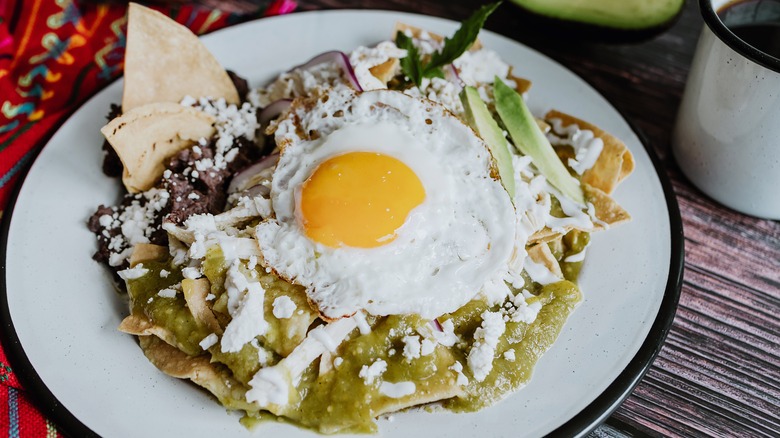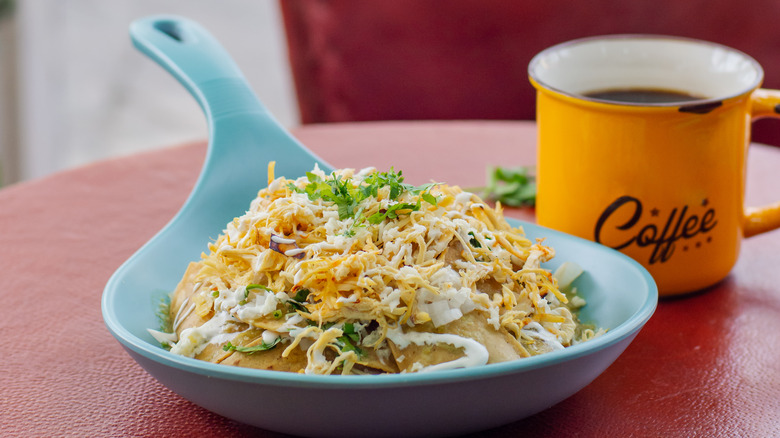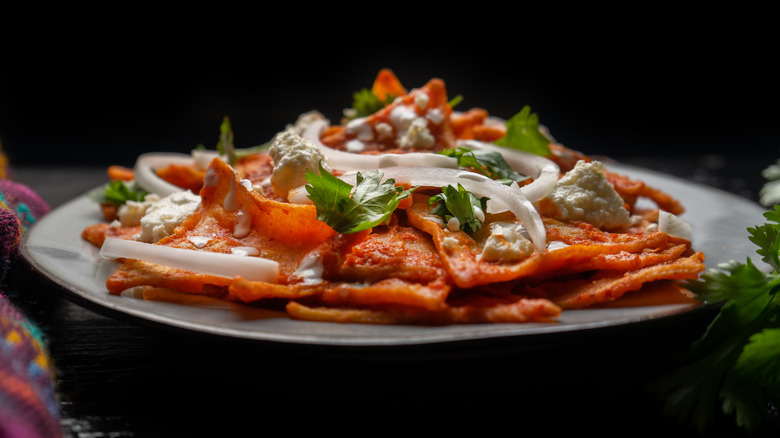Chilaquiles: The Mexican Breakfast Dish That Makes Good Use Of Leftovers
Tortillas are everywhere in Mexico, and most of them are corn. Explorando Mexico calls tortillas "the crucial element of Mexican gastronomy," and points out that they're eaten in every region and by members of every social class. In fact, 630 million corn tortillas are eaten every single day in Mexico, along with another 60 million flour tortillas, most of those in the northern part of the country. Tortillas are present in nearly every traditional dish, and they function in various ways, as the crispy base for a tostada, a flexible way to hold tacos and burritos, and as an eating utensil when they're fried crisp as totopos or chips.
One of the few drawbacks of this versatile flatbread is that making tortillas is a bit labor intensive, and another is that they get stale quickly. Neighborhood tortillerias are the solution, making it easy for both restaurants and families to pick up inexpensive, fresh tortillas daily (per National Geographic). As every restaurant chef knows, along with every home cook, it's impossible to perfectly estimate how much of a given item you'll need for every meal, and that means leftover tortillas, even when you're buying them daily. Some may look at the dry and brittle quality of leftover tortillas as a bad thing, but we see it as an opportunity to make a saucy and satisfying breakfast dish: chilaquiles.
The history and origin of chilaquiles
Chilaquiles aren't a new-fangled invention; the word dates back a bit, with its roots in the Aztec Nahuatl language, according to Taco Guy. Though there are a few different translations, Just Mexican Food explains that the Nahuatl word "chīlaquīlli" is composed of the words "chīlī," which clearly is our "chile," and "aquīlli," meaning "something put in," which reflects our dish — tortillas in delicious sauce. Now, you can find this dish served in restaurants, but it comes from humble origins. Before refrigeration was available, chilaquiles was a way for working class people to repurpose leftover tortillas, per Mic.
Chilaquiles formally migrated to the U.S. in 1898, when Mexican-American chef Encarnación Pinedo published a recipe for the dish in his book "The Spanish Cook," according to Medium. It was also the first cookbook published in the U.S. by a Hispanic writer. This famed hangover dish not only spread into the U.S., Julee Ho Media points out that chilaquiles are popular in Honduras and Guatemala as well.
Chilaquiles are as versatile as they are practical
Though chilaquiles have practically infinite variations, the dish is basically leftover tortillas, fried or toasted, simmered with a salsa, then topped with any number of ingredients. Amigo Foods provides a classic recipe for chilaquiles rojos where tortillas are cut into wedges and toasted in the oven. Then, a fresh salsa made of tomatoes, onions, garlic, and seasoning is blended smooth, then simmered on the stove. The crisp tortillas are folded into the sauce and simmered until the chips soften, then the mixture can be topped with any or all of the following: shredded chicken, avocado, cilantro, cheese, crema, onions, beans, and even eggs.
Leftover refried beans from last night's dinner? Throw them on your chilaquiles! Made too much filling for the previous night's tacos? An avocado that's perfectly ripe? Smoked or pulled meat? Whether you're just using up leftovers or planning to build chilaquiles for an occasion, there's really no ingredient that's off limits. The basic structure of leftover tortillas or chips, simmered in salsa, topped with whatever's on hand is both frugal and flexible. As cookbook author, Lesley Téllez told Mic, "You fry them and douse them in salsa and everybody forgets they were this stale, hard thing just hours before."
How and when are chilaquiles served throughout Mexico?
Chilaquiles can be customized for anyone's palate, but there are three variations worth noting: chilaquiles rojos, which are made with red, tomato-based salsa, chilaquiles verdes, made with green tomatillo-based salsa, as well as chilaquiles blanco, made with a creamy, often cheesy salsa. Regional variations of this leftovers-for-breakfast favorite are full of possibilities for playing with cooking methods and textures. Amigo Foods points out that in Mexico City, the leftover tortillas are simmered in spicy sauce, while in Central Mexico, chips or crisp tortillas are added just before serving so they stay crunchy. In Guadalajara, you might encounter chilaquiles cooked in a clay dish called a cazuela, baked long enough to thicken the tortillas to a polenta-like texture.
As for the when, of course, chilaquiles can be served for any meal, but they're typically breakfast fare. Taco Guy explains that his favorite way to enjoy chilaquiles is after a traditional Mexican wedding, which are typically long affairs that last throughout the night and culminate in festive mariachi music. Lopez writes, "Just as the mariachis sing their last song and shot their last tequila, the chilaquiles make their appearance to give everyone in the party a final boost of energy to send them home." Chilaquiles, apparently, are the perfect hangover food as well.



